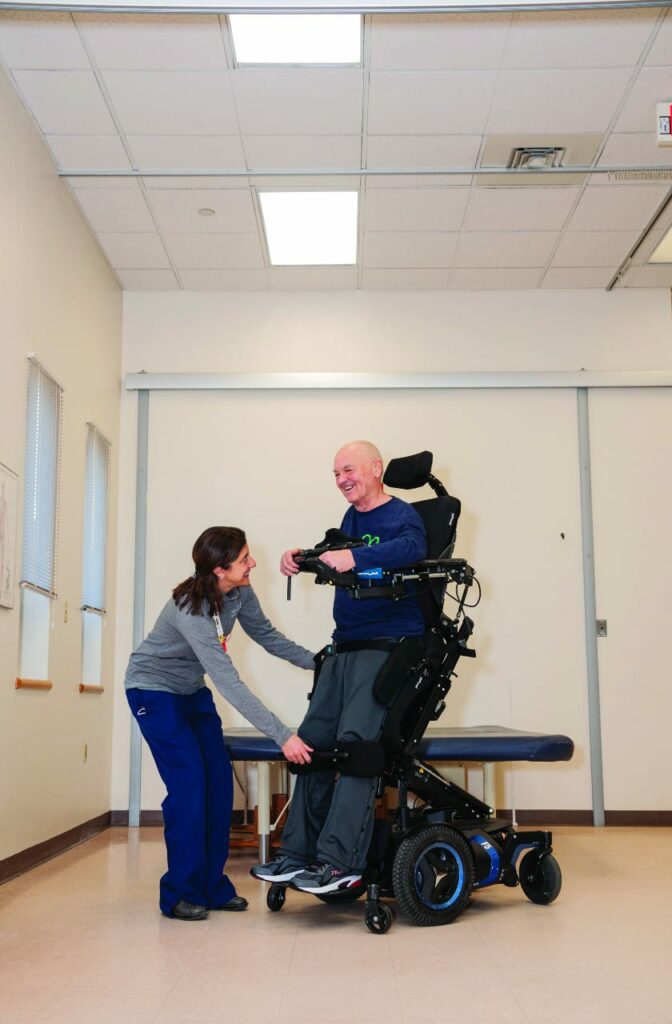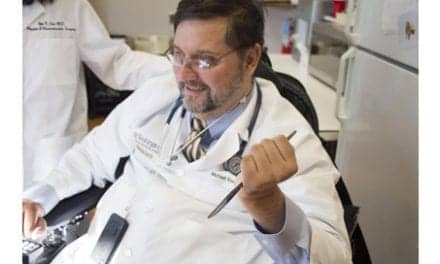Insight into what therapists should know to help clients working toward upright.
By Rehab Management Staff
People affected by a spinal cord injury can greatly benefit from standing, but achieving a standing position can often be problematic. For therapists to acquire a device for a client to stand successfully, they must understand the process.
Jillian Cacopardo, MPT, ATP/SMS, is a physical therapist and the clinical program coordinator for wheelchair assessment services at Gaylord Specialty Healthcare, a provider of complex medical care and rehabilitative services in Wallingford, Conn. In this Q&A, she shares tips every therapist who works with standing should know.
How much of your personal practice was developed through your own personal experience?
Much of my practice was cultivated and guided through the considerable hands-on experience I’ve had in inpatient rehab and subsequent 10 years in my current role as outpatient clinical specialist. It’s not something I learned in school, but something that I’ve picked up through the years and continue to evolve to this day. There’s always something new to learn.

Do you have advice for therapists looking to develop their own expertise in standing?
Reading about the benefits of standing is certainly a great start. The “Position Paper on the Application of Standing Devices” on the RESNA website is an exceptional source that provides further resources to explore. Transferring the information into practice takes time, and I think experience drives a lot of decision-making.
Can you describe the path that most patients take in their journey toward upright?
If somebody comes in and expresses a desire to stand, the first step is to determine if they have already undergone a standing program. If not, we will make sure they are medically cleared through their physiatrist or their primary care physician. Once that information is in-hand, the next step is to trial a standing program to ensure that the patient can progress toward upright without experiencing any adverse reactions. They don’t have to necessarily achieve full upright before we would spec out the equipment via a stationary standing frame or a power stander. But we want to make sure they can safely progress toward upright before submitting for approval.
Can you discuss the importance of progress toward upright?
Achieving a fully upright position is the goal of patients and therapists alike. However, this may not be a reality for those with severe range-of-motion limitations or spasticity. It is important to be able to show progress to the funding source where equipment approval is the ultimate goal. Some patients may actually be able to meet their fully upright goal, but it may take them a while to get there. Starting the funding process early on for these patients is helpful to limit any time lapses between therapy discharge and equipment procurement.
What advice do you have for how to create a letter of medical necessity for standing products?
It is important to have a good relationship with referring physicians. Many of our referral sources are familiar with the clearance necessary to pursue a piece of standing equipment. The medical clearance should be documented in both the letter of medical necessity, as well as in the physician’s documentation.
While there are a lot of benefits that can carry over between patient populations, individualizing the documentation and thinking outside of the box to how these benefits meet the needs of our patients is key.
Are there clinical or social indicators that suggest standing may not be a suitable goal?
It’s truly on a case-by-case basis. I think everything can be read on the flipside of the coin. If somebody gets orthostasis when they go to stand, that can be considered a contraindication. But, if they stand, they might be able to work themselves through the orthostasis. If a patient is osteopenic or osteoporotic, standing could help reverse or slow down that progression. Obviously, there is risk involved. That’s why I really do think that it’s a case-by-case basis and it is important to have the whole “team” on board.
From a social indicator standpoint, patients that have personal care attendants have to determine where they want to allocate the aides’ time. Standing can be a lengthy and labor-intensive process for the aides and may impede on their ability to perform other necessary care tasks, such as hygiene and shopping, due to time constraints. Specifically, some aides are present only in the morning and in the evening and are not necessarily there for the amount of time needed to perform transfers to/from a stationary standing frame and remain with them while they complete their standing program. One needs to keep in mind that the aides have other responsibilities to perform for the patient. Therefore, lack of caregiver support may indicate that a power standing wheelchair is worth investigating.
Can you talk about power wheelchairs that have standing options?
The market for power wheelchairs with standing features has grown over the past few years. Previous power standing wheelchairs were front-wheel-drive models. Today, there are other manufacturers that have been able to put a power stander on a mid-wheel-drive base. This drive setup has opened a lot more doors for people who have accessibility issues where the front-wheel drive won’t fit.
Considering function, health benefits, cost, and probability of user abandonment, is there one type of standing technology that seems to check all the boxes?
When it comes to health benefits and minimizing user abandonment, the power stander checks all the boxes. Users don’t need somebody to get them into the equipment or need multiple caregivers to set them up. They can simply press the button and elevate into standing. Ultimately, it provides independence … which is what every patient wants to achieve.
Do you have any tips for reducing equipment abandonment?
It’s important that whoever will be helping the patient transfer into any kind of standing equipment is present to trial the device with them before pursuing. All too often returning patients have told me they are not using their stationary because it’s too hard to transfer into themselves, or too hard for their caregivers to manage.
What suggestions do you have for how to fund a standing technology?
It’s vitally important to demonstrate to the insurance company or funding source how successful somebody is in standing, how committed they are to their program and how their caregivers are able to assist them if necessary.
To help with funding approval, you need to know what the funding source is and what is written in their policies. Some policies state that standing is not covered. Or maybe a stationary standing frame is covered but the standing component of a power wheelchair is not. Be aware of alternate funding sources. There are different funds that could help subsidize the cost. Crowdfunding can also assist in alleviating costs. There are many different avenues to help meet your standing needs. RM





